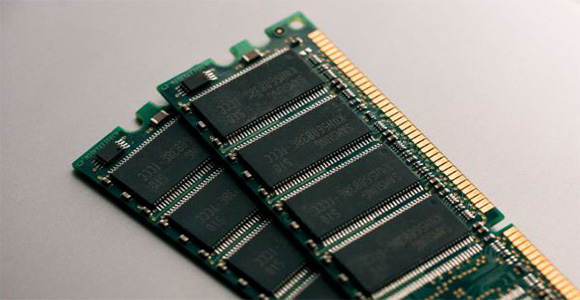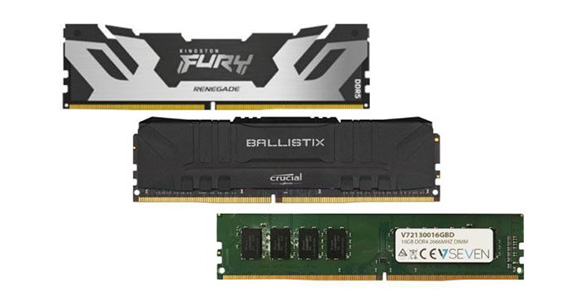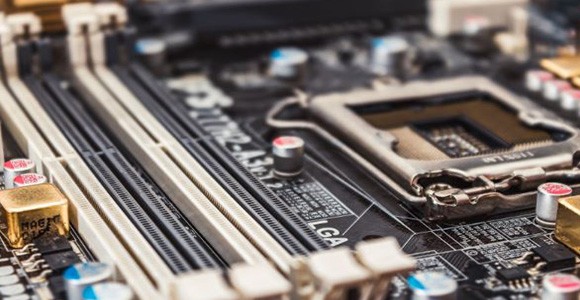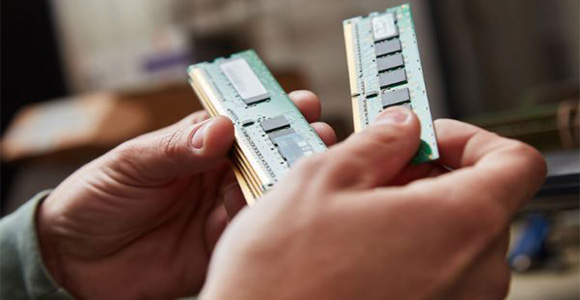
RAM is like your computer’s short-term memory. It’s very, very fast and all the files and apps you open are transferred to it from your mass storage device while you’re using them. In this article we discuss how much you really need to perform your tasks.
RAM is like your computer’s short-term memory. It’s very, very fast and it’s connected directly to the CPU (Central Processing Unit). The files and apps you have open are transferred to it from your mass storage device (like your long-term memory) while you’re using them. If it gets full your system will slow right down to a crawl.
That’s why it’s essential to have enough RAM to perform the tasks you need.
For most users, 8 GB (gigabytes) is the sweet spot. It will give you enough capacity without spending extra on what you don’t need. 4 GB might be enough if you’re a very light user and on a tight budget, and 16 GB is a good investment if you’re doing some gaming or content creation like photo editing. Any more than that is really only needed for high-end gamers playing the most recent games at the highest settings or professionals performing demanding tasks.


So what is RAM?
RAM stands for Random Access Memory. This is a throwback to the very early days of computing when mass storage (like your hard drive or SSD) was linear, with data stored on reels of magnetic tape, or even audio cassette tapes for some home computers. RAM allows the CPU to access any of the data stored in it immediately.
Mass storage has used random access technology for a long time now, but the name has stuck for RAM.
Early computers had RAM capacity measured in kilobytes (KB). The RAM in modern PCs is measured in gigabytes (GB). That means programmers and developers creating software for modern systems have millions of times more space to work in. This is why modern apps and games can be so powerful and complex.
RAM modules (often referred to as sticks) plug into your motherboard and have a channel (or bus) directly to your CPU via a memory controller. This allows your CPU to access RAM incredibly quickly.
What exactly is a gigabyte?
Throughout this article, we talk about RAM capacity in terms of gigabytes, megabytes and kilobytes. But what does that actually mean? What is a gigabyte?
To answer that, we need to talk about bits.
A bit is the single smallest piece of information that a computer can understand. It has two states: on and off, or 1 and 0.
8 bits make a byte. In the olden days of computing, a byte was the number of bits needed to encode a single character of text in a computer, so it’s the smallest addressable unit of memory in a lot of computing systems.
1024 bytes make a kilobyte. Why 1024 and not 1000? Well, it’s because computers usually work on a numerical system called base two. We get to 1024 by doubling from 1 upwards (1 > 2 > 4 > 8 > 16 > 32 > 64 > 128 > 256 > 512 > 1024).
1024 kilobytes make a megabyte. You can probably see where we’re going with this.
Yep, you got it - 1024 megabytes make a gigabyte. We can also go on to terabytes (often used to express the capacity of storage like SSDs), petabytes, exabytes, zettabytes and beyond.
So if we do the maths, that means there are around 8 BILLION bits of information in a gigabyte.


Is there more than one type of RAM?
Yes. There could be several types of RAM in your computer, and different systems use different types.
In this article, we’re mainly talking about system RAM. Modern PC system memory uses DDR-SDRAM. This stands for Double Data Rate-Synchronous Dynamic RAM. We’re up to version 5 of DDR, which was released in 2020, but most PCs in 2023 are still using DDR4.
Let’s unpack all that really quickly.
Dynamic RAM uses capacitors to store data. These need to be refreshed with a burst of energy every few milliseconds. This is less efficient and slower than SRAM (Static RAM) which uses transistors but is far more expensive to manufacture.
Synchronous means that the RAM synchronises with the clock cycles of your CPU. This allows the computer to execute tasks much faster than asynchronous RAM, which runs at its own speed.
Double Data Rate means that information can be exchanged with the CPU twice in each clock cycle. This doubles the speed compared to older SDR (Single Data Rate) RAM.
Desktop or laptop?
Different types of PC may use different standards of RAM module.
- Desktop systems use 288-pin Dual Inline Memory Modules (DIMM).
- Laptops use smaller 260-pin DIMMs.
- All-in-one (AIO) computers could use either type depending on the specific model.
You CANNOT mix and match different RAM formats. They won’t physically fit. So if you’re upgrading, make sure that you check and double-check exactly what you need.
Video RAM (VRAM)
If you have a discrete graphics card (GPU) then this will have its own Video RAM or VRAM. VRAM is even faster than system RAM, but it’s not expandable unless you change your GPU. If you have onboard graphics then it will ‘borrow’ memory from the system RAM.
Cache RAM
Your CPU also has a small cache of RAM. This is built into the CPU and uses SRAM (Static RAM) which is incredibly fast, but also very expensive. CPU cache ram is usually measured in megabytes (MB) rather than gigabytes. There’s no way to upgrade it without changing your CPU.


Does speed matter?
Yes… But probably not that much.
RAM speed is measured in two different ways. The clock frequency is measured in megahertz (MHz). The latency is measured in either Column Address Strobe (CAS) or Column Latency (CL). These are different names for the same measurement.
The relationship between these two measurements is complex. But the important thing to understand is that higher frequency and lower latency will both contribute to better performance, but the frequency is probably the more important measurement.
If you’re a light user, the speed probably doesn’t matter at all. You won’t see any noticeable difference in day-to-day use. For most gamers and creators, you should probably be looking at the faster end of the DDR4 range. A frequency of 3200-3600 MHz (depending on your CPU) with a CL of 16-18 should be more than adequate.
If you’re building a super high-end system with DDR5 RAM then you’ll probably be looking at something like 6000 MHz with a CL of 30-36. But DDR5 is currently really only needed for very high-performance systems, and remember you’ll need to make sure your motherboard supports it.


What’s this I’ve heard about dual-channel RAM?
Your motherboard probably has either two or four slots for memory sticks. Most motherboards have two 64-bit channels (or buses) connecting those slots to the CPU. If you want 16 GB of RAM, and you install a single 16 GB stick, then you’ll only be using one of those channels.
On the other hand, if you install two 8 GB sticks, you’ll be doubling the data bandwidth between your CPU and your RAM. 3200 MHz RAM has a data transfer rate of 25.6 GB/s. If you use a dual-channel setup then you’re doubling that up to 51.2 GB/s.
That’s a huge increase, and if you’re gaming or using creative applications then you’ll really see the difference. In fact, some games can be almost unplayable using a standard single-channel setup. On the other hand, if you’re a comparatively light user then a single 8 GB stick will be fine - you probably won’t notice if you switch to dual-channel.
If you do want to go dual-channel then it’s best to buy your RAM in kits so everything is matched up nicely. It’s also important to make sure you install the sticks in the right slots in your motherboard - you’ll be able to check this in the manual, but often you’ll need to use slots 2 and 4.


Can I add more RAM?
Probably.
It all depends on your system, and whether you have a desktop or a laptop.
If you have a laptop or all-in-one PC then you might be stuck with what you have. Often RAM will be soldered to the motherboard, and you won’t be able to add more or change it. If you’re unsure you’ll have to do a bit of digging on your particular model to see what’s possible.
If you have a regular desktop PC then there’s a good chance that you can slot some new RAM in pretty easily.
Pop open your case and have a look - you’ll probably have two or four RAM slots. If you have some empty then happy days - you can buy some new RAM and plug it straight in. Ideally, you want all of your modules to match, so you might need to do some shopping around. At the very least you’ll want to make sure that frequency and latency are the same across the board.
If all your slots are full, then you’ll have to take out the existing RAM and replace it with higher-capacity modules.
You’ll also need to check that the version of Windows you’re running supports more RAM than you already have. If you’re on Windows 11, you don’t need to worry - even the lowest spec version (Windows 11 Home) supports up to 128 GB, which is way more than you’re likely to need.
If you’re still on Windows 10 or lower though, you’ll need to check whether you’re on a 32-bit or 64-bit version.
In Windows 10 or 8.1, you can do this by pressing the ‘Start’ button on your taskbar, then going to Settings > System > About. Under Device specifications, there’s a section called System type.
If you’re still on Windows 7 then you can press ‘Start’ on the taskbar, right-click on Computer and go to Properties. You’ll find the info you need under System.
If you’re still running a 32-bit version of Windows, you’ll be limited to 4 GB of RAM. You can put more in, but Windows won’t recognise it.
If you’re on 64-bit the limit will vary. You can check the limit for your version on the Microsoft website.
Whatever you do, when adding or replacing RAM, make sure that what you buy is compatible with your motherboard. You won’t be able to add DDR5 RAM to a board that supports DDR4, for example.


How important is RAM?
RAM is a vital part of a well-balanced, sensibly specced computer.
You need to make sure that all of the components of your PC will work well together and complement each other to give you the experience you want. And that really depends on what you want from your PC.
If all you do is web browsing and word processing, then an entry-level processor, integrated graphics and 8 GB of whatever type of DDR RAM your motherboard supports will probably be plenty.
If you want to play games but you’re not worried about the highest frame rates or graphics settings then you’ll probably be fine with a mid-range CPU and graphics card from the last few years, and 16 GB of DDR4 RAM. If you want a bit more headroom to do creative tasks like video editing or 3D modelling then it might be worth upgrading to 32 GB.
It’s really only if you’re looking at playing the very latest games on the highest settings or editing lots of videos (especially at 8k) that you might want to be looking at a system with 32 GB or even more DDR5 RAM. You’ll also need the newest motherboard, CPU and GPU for a balanced system that can make the most of that kind of speed and capacity.


So how much do I really need?
There’s really no simple answer to this, as it completely depends on how you use your computer and what operating system you have.
It’s also worth noting that adding more RAM than you need won’t speed things up - if you have enough, then that’s as good as you’ll get.
Microsoft’s recommended minimum RAM capacity for Windows 11 is 4 GB. For Windows 10, Windows 8.1 and 7 it’s 1 GB if you’re on a 32-bit version and 2 GB for 64-bit.
But this is very much a minimum. Even for a light user, a web browser like Chrome or Edge with a few open tabs can fill up the available space very quickly. Open up a word processor, photo viewer or music player like Spotify and you can reach capacity - and slowdown - very quickly.
So we’d recommend that if you can when you buy a new computer, try and aim for at least double the recommended spec. RAM is not too expensive, and it could make the difference between a computer that never gets touched because it’s so slow and one that can perform the tasks you need without fuss.
If you want to use your computer for more than just browsing websites and typing the odd document then we’d recommend upping the RAM to at least 8 GB whatever version of Windows you’re using. It’ll give you the capacity to comfortably run a few apps at once, play some modern games at lower settings and do basic photo editing too.
16 GB of dual-channel RAM is probably a worthwhile investment if you’re more serious about gaming, or if you want to try your hand at content creation like editing videos or photos, music production or 3D modelling. Paired with the right CPU and GPU it should give you the overhead to get close to those higher-quality game settings and framerates. You should be able to edit up to 4k videos and work on big Photoshop files too.
You’ll need to be pretty keen on high-end gaming or content creation to justify 32 GB. But on the other hand, compared to upgrading your CPU or GPU adding extra RAM is fairly cheap, and will give you the ability to multitask demanding apps with no stuttering. It’ll also make your computer a little bit more future-proof.
